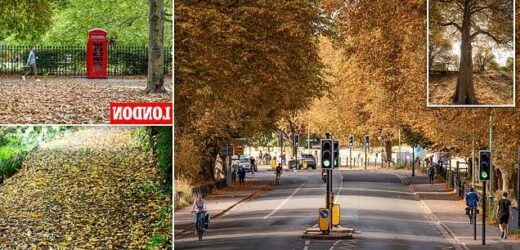Britain’s drought sparks ‘false Autumn’: Trees turn golden brown and leaves cover footpaths as they conserve water in the August heat – while experts warn phenomenon could impact wildlife in winter months
- Striking images reveal fall’s appearance a month early as experts say trees are pushed into ‘survival mode’
- The unexpected seasonal shift shows the effects of an exceptionally hot and dry summer across the country
- ‘False autumn’ effect may be a precursor to many thousands of trees dying years before their natural life ends
- Elsewhere blackberries, hawthorn berries, hazelnuts and other fruits are appearing much earlier than usual
Britain’s trees have turned a sea of reds and oranges while leaves crunch underfoot as weeks of extreme temperatures and drought have sparked a ‘false autumn’, which has led to warnings of trouble for wildlife when the weather turns colder.
Striking images from across the country reveal golden-brown branches and dried-up leaves along footpaths much earlier than usual.
The unexpected seasonal shift, which has been made more likely by climate change, shows the effects of an exceptionally hot and dry summer – also known as a ‘false autumn’ – which experts say has pushed trees into ‘survival mode’ all over the UK.
As a result of the stress, trees have been prematurely shedding or changing the colour of their leaves to conserve water and energy in a bid to survive the weather.
With summer not due to officially end until September 23, experts have said fall’s August appearance is a sign that the heatwave and low rainfall has brought on a ‘false autumn’, as trees abandon their normal seasonal cycles and close down early.
Britain’s trees (Horse Chestnut trees in Cambridge pictured) have turned a sea of reds and oranges while leaves crunch underfoot as weeks of extreme temperatures and drought have sparked a ‘false autumn’
Striking images (Brunswick Park, London pictured) from across the country reveal golden-brown branches and dried-up leaves along footpaths much earlier than usual
As a result of the stress, trees have been prematurely shedding or changing the colour of their leaves to conserve water and energy in a bid to survive the weather (fallen leaves at the Lukesland Gardens in Devon pictured)
The unexpected seasonal shift, which has been made more likely by climate change, shows the effects of an exceptionally hot and dry summer – also known as a ‘false autumn’ – which experts say has pushed trees into ‘survival mode’ all over the UK (Horse Chestnut trees in Cambridge pictured)
It has been warned the ‘false autumn’ effect may be a sign of wider problems for wildlife when October and November arrive as well as a precursor to many thousands of trees dying years before their natural life ends.
Leigh Hunt, senior horticultural advisor at the Royal Horticultural Society, told the BBC that the early leaf fall and auburn leaves are signs trees are ‘shutting up shop’.
He added: ‘It’s giving the appearance that we’re already in autumn, but the days are too long for those natural autumn processes to begin. Physiologically, the plants are not responding to autumn conditions; that’s why we term it loosely as “false autumn”.’
A leading local nature conservation charity has warned autumn’s store of nuts and berries may already be severely depleted by the time October and November come around, causing a risk of scarcity for birds and mammals.
It has been warned the ‘false autumn’ effect may be a sign of wider problems for wildlife when October and November arrive as well as a precursor to many thousands of trees dying years before their natural life ends (pictured, a worker gathers up leaves that have fallen in the ‘false autumn’)
With summer not due to officially end until September 23, experts have said fall’s August appearance is a sign that the heatwave and low rainfall has brought on a ‘false autumn’, as trees abandon their normal seasonal cycles and close down early (pictured, Lorna Howell dealing with early fallen leaves at the Lukesland Gardens in Devon)
The Devon Wildlife Trust said it has spotted signs of false autumn at 60 nature reserves it manages across the county, adding that the phenomenon has been particularly apparent in the South West.
One member of the trust’s nature reserve team remarked that in the last 30 years, they had never seen so many trees experience leaf loss so early in the year.
When leaves turn brown early it is a sign the tree is stressed and trying to conserve water that would otherwise be lost through the process of photosynthesis.
It is worse for young trees that do not have the deep root systems that older trees use to reach water, the Wildlife Trust explained.
The Devon Wildlife Trust said it has spotted signs of false autumn at 60 nature reserves it manages across the county, adding that the phenomenon has been particularly apparent in the South West (Horse Chestnut trees in Cambridge pictured)
When leaves turn brown early (leaves at the Lukesland Gardens in Devon pictured) it is a sign the tree is stressed and trying to conserve water that would otherwise be lost through the process of photosynthesis
Elsewhere blackberries, hawthorn berries, hazelnuts and other fruits are appearing much earlier than usual, with reports suggesting the drought has made many wild fruits smaller and less juicy than normal.
A conservation charity that records seasonal changes received its earliest ever sighting of blackberries on June 28.
Fritha West, from the Woodland Trust, said: ‘The record-breaking heat we have just experienced has helped bring on a number of early autumn events.
‘We have received some of our earliest ever ripe blackberry records from the south of England. Hawthorn and rowan are also ripening early in some parts of the country, where early leaf tinting has also been observed.’
Despite some recent rainfall, the Devon Wildlife Trust is now asking the public to continue putting out a regular supply of water at ground level in their gardens, so it is accessible to animals such as hedgehogs and badgers, as well as traditional bird baths.
People can also put out high energy foods, such as sunflower hearts, nuts and fat balls for birds, and commercially available hedgehog food at ground level.
Leigh Hunt, senior horticultural advisor at the Royal Horticultural Society, described the early leaf fall and auburn leaves as signs trees are ‘shutting up shop’ (trees with auburn leaves at the Lukesland Gardens in Devon pictured)
One member of the The Devon Wildlife Trust’s nature reserve team remarked that in the last 30 years, they had never seen so many trees experience leaf loss so early in the year (pictured, Horse Chestnut trees in Cambridge that are losing their leaves)
Devon Wildlife Trust spokesman Steve Hussey said: ‘For some trees this may be the last straw – the long dry spell will mean they won’t be able to survive. For others, it could mean they are weakened and more open to tree diseases in the future.’
Mr Hussey said: ‘A very early and thinner, less bountiful wild harvest will present a further challenge to many of the birds and mammals which rely on a diet of berries, nuts and seeds to build-up their reserves of body fat before the onset of winter.
‘Take dormice, as just one example – these are animals which must maximise their bodyweight in October and November in order to have a better chance of surviving their long winter hibernation.
‘To do this they will consume large numbers of high fat foods, especially hazelnuts, during autumn. But if those hazelnuts and other hedgerow fruits have already been and gone in August then that presents them with a real problem.’
He continued: ‘Nature’s timing is everything for our wildlife. The climate crisis is bringing with it seasonal weather patterns which our wildlife is just not adapted to.
‘Our long, hot summer and the “false autumn” will have a knock on for many species right into the real autumn months and beyond.’
Source: Read Full Article












